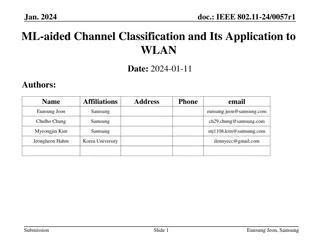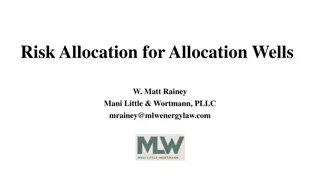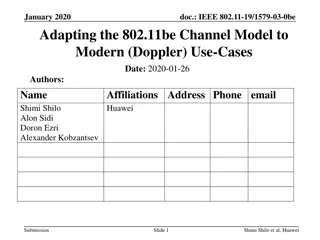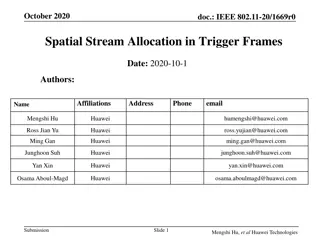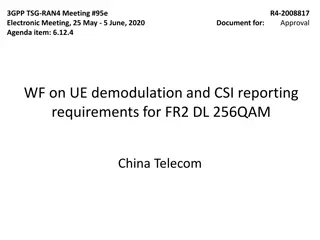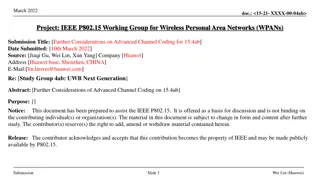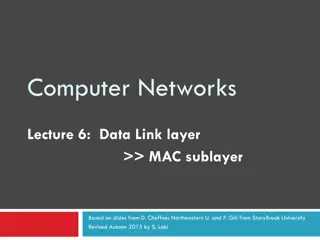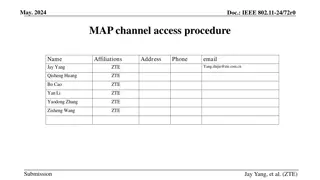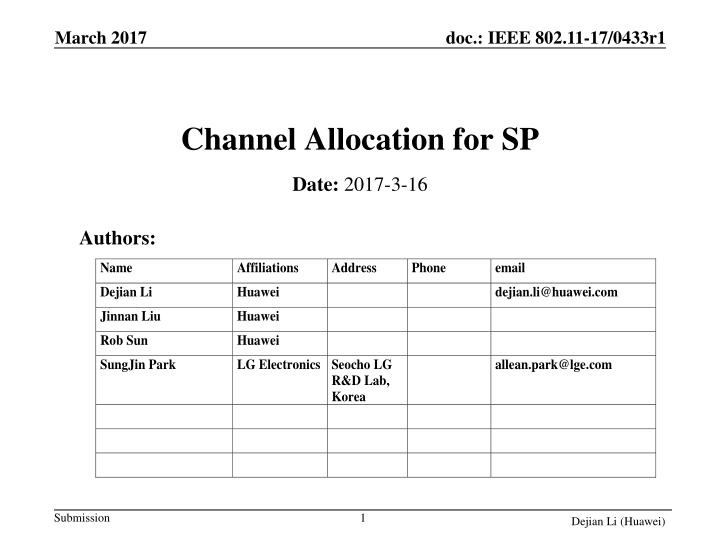
Channel Allocation Strategies for IEEE 802.11-17 Standard
Explore the need for specific channel allocation methods within the IEEE 802.11-17 standard to enhance communication efficiency and flexibility. The discussion covers the importance of channel number and width indications for various scenarios, such as interference avoidance and schedule optimization. These strategies aim to facilitate optimal channel selection for better network performance in dense scenarios.
Uploaded on | 3 Views
Download Presentation

Please find below an Image/Link to download the presentation.
The content on the website is provided AS IS for your information and personal use only. It may not be sold, licensed, or shared on other websites without obtaining consent from the author. If you encounter any issues during the download, it is possible that the publisher has removed the file from their server.
You are allowed to download the files provided on this website for personal or commercial use, subject to the condition that they are used lawfully. All files are the property of their respective owners.
The content on the website is provided AS IS for your information and personal use only. It may not be sold, licensed, or shared on other websites without obtaining consent from the author.
E N D
Presentation Transcript
March 2017 doc.: IEEE 802.11-17/0433r1 Channel Allocation for SP Date: 2017-3-16 Authors: Name Affiliations Address Phone email Dejian Li Huawei dejian.li@huawei.com Jinnan Liu Huawei Rob Sun Huawei SungJin Park LG Electronics Seocho LG allean.park@lge.com R&D Lab, Korea Submission 1 Dejian Li (Huawei)
March 2017 doc.: IEEE 802.11-17/0433r1 Introduction In 11ay draft, AP/PCP allocates channel(s) using BW and Channel Aggregation fields of the EDMG Extended Schedule element. We propose that AP/PCP allocates SP over channel(s) according to the channel number or channel width indication in the SP request. Channel number indication: the same as BW and Aggregation fields in EDMG- Header-A) Channel width indication: desired to support the following rule. For an SP, the allocation does not have to include the primary channel (10.36.11.2) Submission 2 Dejian Li (Huawei)
March 2017 doc.: IEEE 802.11-17/0433r1 Why Channel Number is needed There exists cases that s STA needs to designate a specific channel using channel number indication Case 1: Designate a channel that does not have interference Case 2: In order to accommodate AP s flexible schedule, a STA may intend to perform BRP on each channel We assume BRP training results are channel/frequency dependent. Case 1: STA experienced interference on CH1, intends to request SP on CH2 Case 2: BRP was performed on CH1, but not on CH2 yet Channel 1 (Primary Channel) ... ... ... time Poll1 SPR1 Grant1 Channel Number is needed Channel 2 time SP Submission 3 Dejian Li (Huawei)
March 2017 doc.: IEEE 802.11-17/0433r1 Why Channel Width is needed (1/2) Channel width better supports the following rule than channel number : For an SP, the allocation does not have to include the primary channel. For example, a pair of STAs both support 6.48 GHz may have multiple 2.16/4.32GHz channels for SP allocation. 2.16 GHz: N, N+1, N+2 4.32 GHz: Channel A, Channel B Channel B Channel A ... N N+1 N+2 ... Primary CH Secondary CH Secondary CH Channel width is used to request any one channel satisfying the channel width requirement In comparison, channelnumber can only designate a specific channel. Submission 4 Dejian Li (Huawei)
March 2017 doc.: IEEE 802.11-17/0433r1 Why Channel Width is needed (2/2) channel width can be used for BF training/ transmissions that does not need to designate the channel number: Enable flexible and efficient SP allocation for dense STAs: channel width can avoid potential channel request collisions of dense STAs. SLS: any single channel may be enough BRP: if BRP was performed only on the maximum bandwidth, another BRP is required on any narrower channel to enable following link adaptation or flexible SP schedule Link adaptation: any narrower bandwidth may be enough Submission 5 Dejian Li (Huawei)
March 2017 doc.: IEEE 802.11-17/0433r1 Signaling for Channel Request for SP The BW, Channel Aggregation and IsChannelNumber fields in the SP Request (SPR) and DMG ADDTS Request frames. IsChannelNumber indicates the BW field is channel number or channel width Frame SPR Field/element Control Trailer Content IsChannelNumber, BW and Channel Aggregation Note IsChannelNumber is only valid in the control trailer of SPR; it is reserved in control trailer of other frames. IsChannelNumber, BW and Channel Aggregation DMG ADDTS Request DMG TSPEC element Submission Dejian Li (Huawei) 6
doc.: IEEE 802.11-17/0433r1 Proposed SP Allocation (1/2) Channel number and channel width indications are proposed for two kinds of SP allocations: DMG ADDTS Request/Response sequence Poll/SPR/Grant sequence Dynamic SP allocation: partial channel transmission may occur Since AP knows each STA s available channels, AP can allocate a appropriate channel for partial channel transmission. Polling Period Grant Period Channel 1 (Primary Channel) ... ... ... ... time Poll1 SPR1 Grant1 Grant2 SP2 Partial channel transmission ... Channel 2 time SP1 Submission 7 Dejian Li (Huawei)
March 2017 doc.: IEEE 802.11-17/0433r1 Proposed SP Allocation (2/2) AP/PCP uses the BW and Channel Aggregation fields in the Grant frame and DMG ADDTS Response frame for SP allocation. Frame Grant Field/element Control Trailer Content BW, Channel Aggregation fields specify the channel(s) over which the allocation is scheduled on. same as the corresponding fields in EDMG- Header-A DMG ADDTS Response DMG TSPEC element The EDMG AP or PCP allocates channel(s) as follows, If the BW field indicates the channel width, the AP or PCP may allocate a channel with channel width less than or equal to the value of the BW field. If the BW field indicates the designated channel number, the AP or PCP should allocate the channel as indicated by the BW field Submission 8 Dejian Li (Huawei)
March 2017 doc.: IEEE 802.11-17/0433r1 Conclusion Channel allocation according to channel number indication (BW and channel aggregation fields) or channel width is proposed for the following two kinds of SP requests/allocations. DMG ADDTS Request/Response Poll/SPR/Grant Submission 9 Dejian Li (Huawei)
doc.: IEEE 802.11-17/0433r1 Straw Poll 1 Do you agree that the text in contribution 17/0434r1 (Draft Text for Channel Allocation for SP) shall be incorporated in the 11ay draft? Yes No Abstain Submission 10 Dejian Li (Huawei)




